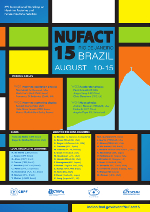Speaker
Dr
C. M. Castromonte
(Universidade Federal de Goiás)
Description
Atmospheric muons are produced when primary cosmic ray nuclei interact near the top of the atmosphere to produce hadronic showers which contain pions and kaons. These secondary mesons can either interact in further collisions in the atmosphere or decay to produce atmospheric muons. Since the majority of primary cosmic rays are protons, there is an excess of positively charged mesons in the showers, and consequently, the atmospheric muon charge ratio Rμ = Nμ+ / Nμ− , defined as the number of positive over negative muons, is larger than unity. Its expected that heavier elements become a more important component of cosmic ray primaries as the energy increases. This increasingly heavy composition would decrease the ratio of primary protons to neutrons, which in turn, would decrease the muon charge ratio. With careful measurements of the muon charge ratio in the cosmic rays, models of the interactions of cosmic rays in the atmosphere can be improved.
The MINOS Far Detector is a magnetized planar steel-scintillator detector situated underground at depth of 2070 mwe. A small fraction of the cosmic ray muons observed in the MINOS FD contain multiple muons. Using the complete MINOS atmospheric data set we will present the first measurement of the multiple muon events charge ratio Rμ = Nμ+ / Nμ− . Systematic uncertainties on the charge ratio were minimized by utilizing data collected with both forward and reversed magnetic field running.
Primary author
Dr
C. M. Castromonte
(Universidade Federal de Goiás)
Co-authors
Dr
M. C. Goodman
(Argonne National Laboratory)
Dr
P. Schreiner
(Argonne National Laboratory)
Dr
R. A. Gomes
(Universidade Federal de Goiás)
